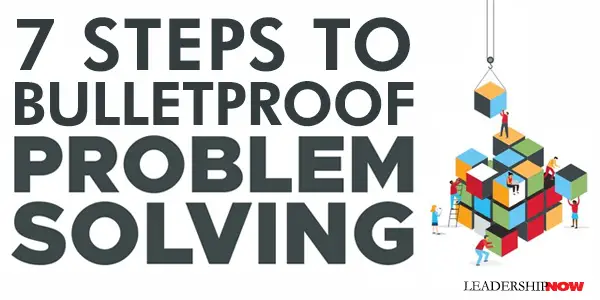 |
 |
10.03.19

7 Steps to Bulletproof Problem Solving
THE WORLD ECONOMIC FORUM’S Future of Jobs Report lists complex problem-solving as the number one skill for jobs in 2020. Organizations are looking for people that can define problems and form solid creative responses. Like leaders themselves, good problem solvers are made, not born. Yet these skills are rarely taught. That’s where Bulletproof Problem Solving comes in. McKinsey alums Charles Conn and Rob McLean teach us how to be bulletproof problem solvers using a simple 7-steps approach. The approach has its foundation in the hypothesis-driven structure of the scientific method. This process is not just applicable to business but is useful in finding solutions for personal problems as well. In the book they apply the process to individual problems such as, “Should I put solar panels on my roof?,” “What career should I choose?,” and “Is where I live affecting my health?” Business examples range from “Should my startup raise its prices?” and “Should we go to court?” to “Can obesity be reduced?” This process can be applied to nearly every problem is responds well to the systematic problem-solving method that this approach provides. The Seven Steps to Bullet-Proof Problem Solving are: Step One: Define the Problem
Step Two: Disaggregate the Issues
Step Three: Prioritize the Issues, Prune the Tree
Step Four: Build a Workplan and Timetable
Step Five: Conduct Critical Analyses
Step Six: Synthesize Findings from the Analysis
Step Seven: Prepare a Powerful Communication
While this is presented in a linear way, the authors make a great point that you learn more about the problem as you go. You shouldn’t be so eager to get to the end that you don’t go back and refine previous steps. “While the process has a beginning and an end, we encourage you to think of problem solving as an iterative process rather than a linear one. At each stage we improve our understanding of the problem and use those greater insights to refine our earlier answers.”

Posted by Michael McKinney at 04:30 AM
|
BUILD YOUR KNOWLEDGE
 

How to Do Your Start-Up Right STRAIGHT TALK FOR START-UPS 
Grow Your Leadership Skills NEW AND UPCOMING LEADERSHIP BOOKS 
Leadership Minute BITE-SIZE CONCEPTS YOU CAN CHEW ON 
Classic Leadership Books BOOKS TO READ BEFORE YOU LEAD |